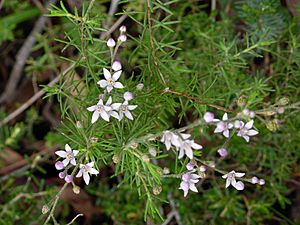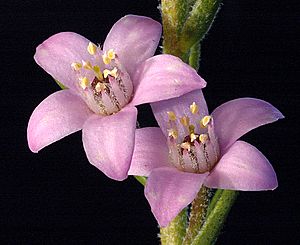Pepper and salt facts for kids
Quick facts for kids Pepper and salt |
|
|---|---|
 |
|
| In Kalamunda National Park | |
| Scientific classification | |
| Genus: |
Philotheca
|
| Species: |
spicata
|
| Synonyms | |
|
|
Philotheca spicata, often called pepper and salt, is a beautiful flowering plant. It belongs to the Rutaceae family, which also includes citrus fruits like oranges and lemons! This plant is special because it only grows in the south-west part of Western Australia. It's a small bush with thin leaves and pretty pink, purple, or blue flowers. These flowers grow in clusters at the ends of its branches.
Contents
What Does Pepper and Salt Look Like?
Pepper and salt is a small bush, usually growing about 30 cm (12 in) to 60 cm (24 in) tall. Its branches are smooth. The leaves are long and narrow, like tiny needles, and are about 6 mm (0.24 in) to 20 mm (0.79 in) long. They have a slight curve, making the top surface a bit hollow.
The flowers grow in long groups called racemes. These racemes can be 15 cm (5.9 in) or more in length and don't have leaves. Each flower has small, broad, oval-shaped bracts at its base. The flower sits on a thin stalk, called a pedicel, which is about 7 mm (0.28 in) long.
Each flower has five triangle-shaped sepals, which are about 1.5 mm (0.059 in) long. The petals are broad and oval, about 4.5 mm (0.18 in) long. Inside the flower, there are ten stamens, which are the parts that produce pollen, and they are about 2 mm (0.079 in) to 2.5 mm (0.098 in) long.
Pepper and salt plants bloom from June to November. After flowering, they produce small fruits, about 3 mm (0.12 in) long, with two tiny teeth at the end.
How Did Pepper and Salt Get Its Name?
The scientific name for this plant, Philotheca spicata, has an interesting history. It was first described in 1834 by a French botanist named Achille Richard. He originally named it Erisotemon spicatus.
Later, in 1998, another botanist named Paul G. Wilson decided to change its name to Philotheca spicata. This change was published in a science journal called Nuytsia. Scientists sometimes change plant names as they learn more about how different species are related.
Where Does Pepper and Salt Grow?
Pepper and salt plants grow in sandy soil or a mix of sand and clay, often over a type of rock called laterite. You can find this plant in the south-west region of Western Australia. Its natural home stretches from a town called Eneabba all the way down to Albany.
Is Pepper and Salt Safe?
The Government of Western Australia's Department of Parks and Wildlife has looked at the pepper and salt plant. They have classified it as "not threatened." This means that currently, there are enough of these plants in the wild, and they are not at risk of disappearing.


